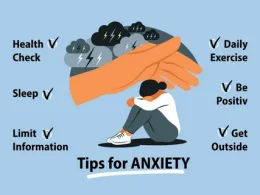Living with chronic pain can be a daily struggle that affects your physical, emotional, and mental well-being. Whether it’s caused by an injury, illness or other factors, chronic pain can significantly impact your quality of life. Fortunately, there are ways to manage this condition effectively and regain control over your life. In this blog post, we’ll explore the causes and types of chronic pain as well as share some practical tips on how you can alleviate the symptoms and live a fulfilling life despite the challenges posed by chronic pain. So if you’re looking for solutions to ease your discomfort and improve your overall health, keep reading!
What is chronic pain?
Chronic pain is a long-lasting condition that persists beyond the normal healing time. Unlike acute pain, which lasts for a short period of time and goes away once the underlying cause has been addressed, chronic pain can persist for weeks, months or even years. It affects millions of people worldwide and can be caused by a variety of factors.
Some common causes of chronic pain include injury, nerve damage, arthritis, cancer treatments such as chemotherapy or radiation therapy, fibromyalgia and other medical conditions. The severity of chronic pain varies from person to person and can range from mild discomfort to excruciating agony that significantly impairs daily activities.
In addition to physical symptoms such as muscle tension, stiffness and weakness in affected areas, chronic pain can also have emotional effects like depression and anxiety. Living with this condition can be challenging but it’s important to understand that there are ways to manage it effectively through various treatment options including medications or alternative therapies like massage therapy or acupuncture.
Managing chronic pain requires patience and perseverance but taking positive steps towards relieving your symptoms can help you regain control over your life.
Causes of chronic pain
Chronic pain is a complex condition that affects millions of people worldwide. The causes of chronic pain can vary widely and are often difficult to pinpoint. In many cases, it is the result of an injury or illness that has caused permanent damage to the body’s tissues, nerves, or organs.
One common cause of chronic pain is arthritis, which occurs when there is inflammation in one or more joints in the body. This can cause stiffness and pain in the affected area and may make it difficult for individuals to carry out their daily activities.
Another potential cause of chronic pain is fibromyalgia, which is a disorder characterized by widespread musculoskeletal pain and fatigue. It can be challenging to diagnose as its symptoms often overlap with other conditions such as depression and anxiety.
In some instances, chronic pain may develop after surgery or due to nerve damage caused by trauma or infection. Chronic headaches or migraines are also prevalent causes of ongoing discomfort that require attention from healthcare professionals.
Chronic stress has also been linked to causing physical symptoms akin to those experienced during episodes of acute stress including neck & back pains among others.
There are numerous possible causes behind chronic pain; however identifying them accurately requires professional medical care coupled with diagnostic tests like MRI scans so as not underestimate nor overestimate the problem at hand.
Types of chronic pain
Chronic pain is not a one-size-fits-all condition. There are different types of chronic pain, each with unique characteristics and symptoms. Here are some of the most common types:
1. Nociceptive Pain: This type of pain occurs when there is damage to tissue or organs in the body, such as from an injury or surgery.
2. Neuropathic Pain: This type of pain results from damage to nerves, often causing burning or shooting sensations.
3. Inflammatory Pain: Inflammation caused by conditions like arthritis can cause this type of chronic pain.
4. Functional Pain: Sometimes called idiopathic pain, this type has no known physical cause and may be linked to psychological factors.
5. Phantom Limb Pain: Following amputation surgeries, some people experience phantom limb pain – a sensation that their missing limb still exists and is painful.
6. Cancer-Related Pain: People living with cancer may experience various types of chronic pains resulting from tumors pressing on nerves, bones or other tissues.
It’s important for individuals with chronic pain to work closely with healthcare providers to identify the specific type(s) they are experiencing in order to develop effective management strategies tailored specifically for them
Symptoms of chronic pain
Chronic pain is characterized by persistent and long-lasting pain that lasts for more than three months. The symptoms of chronic pain are different for everyone, but it often comes with emotional and physical effects on the body.
Physical symptoms of chronic pain include constant or intermittent aches, sharp stabbing pains, burning sensations, stiffness in the joints or muscles, fatigue, sleep disturbances and decreased mobility. These physical symptoms can make daily tasks difficult to complete.
The emotional effects of chronic pain include depression, anxiety and stress. Living with chronic pain can lead to social isolation due to limitations in activities one can participate in. It also leads to frustration when treatments do not work as well as expected leading people to feel hopeless about their condition.
Other signs of chronic pain include changes in appetite such as reduced appetite or overeating; mood swings ranging from irritability to anger; difficulty sleeping due to increased discomfort at night which leads people feeling exhausted during the day.
Chronic pain affects an individual’s daily life severely making it important for doctors and patients alike take this issue seriously while working together towards effective management strategies.
Conclusion
Living with chronic pain can be a challenging and overwhelming experience. However, there are effective strategies that individuals with chronic pain conditions can use to manage their symptoms and improve their quality of life.
It’s essential to understand the causes and types of chronic pain, as well as its symptoms, so that you can get an accurate diagnosis from your healthcare provider. From there, you can work together to develop a comprehensive treatment plan that may include medication, physical therapy or other alternative therapies.
In addition to medical treatments, lifestyle changes such as regular exercise, healthy eating habits and stress management techniques like meditation or yoga have also been shown to reduce chronic pain levels.
Living with chronic pain requires patience and commitment but implementing these strategies consistently over time will help in better managing it effectively while improving your overall wellbeing.











